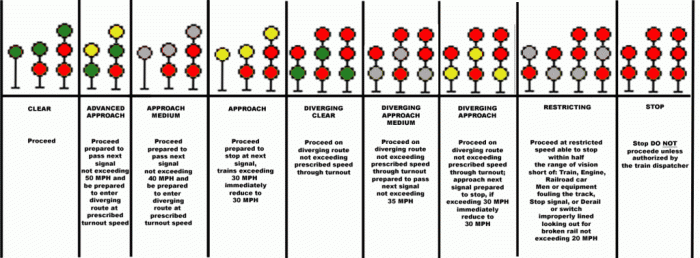How to read train signals – Delve into the fascinating world of train signals and unlock the secrets of reading these essential indicators that guide trains safely and efficiently along the tracks. From understanding signal aspects and interpreting indications to exploring signal systems and technology, this comprehensive guide empowers you to become a confident interpreter of train signals.
As you journey through this guide, you’ll gain a deep understanding of the purpose and significance of train signals, enabling you to navigate the complexities of rail travel with ease and confidence.
1. Introduction to Train Signals
Train signals are essential for ensuring the safe and efficient operation of railways. They provide instructions to train drivers, indicating the status of the track ahead and the actions they need to take. Understanding train signals is crucial for the safety of both passengers and railway staff.
Types of Train Signals, How to read train signals
- Fixed Signals: These are permanent signals located alongside the track, displaying aspects that convey information about the track ahead.
- Cab Signals: These are signals displayed inside the train’s cab, providing information about the track ahead and the train’s speed.
- Hand Signals: These are signals given by hand by railway staff, typically used for shunting or in emergencies.
2. Understanding Signal Aspects: How To Read Train Signals
Signal aspects are the different colors, shapes, and positions of train signals that convey specific meanings. Each aspect represents a particular state of the track ahead and the actions required by the train driver.
Meaning of Signal Aspects
| Aspect | Meaning |
|---|---|
| Green | Clear track ahead, proceed at normal speed |
| Yellow | Caution, proceed with reduced speed |
| Red | Stop |
3. Interpreting Signal Indications
Interpreting signal indications involves understanding the meaning of each aspect and taking appropriate action.
Actions for Different Signal Indications
- Green: Proceed at normal speed, observing any speed restrictions.
- Yellow: Slow down and prepare to stop at the next signal.
- Red: Stop immediately and wait for further instructions.
4. Signal Systems and Technology
There are various types of signal systems used in railways, each with its own technology.
Types of Signal Systems
- Mechanical Signal Systems: Traditional systems using levers and wires to operate signals.
- Electric Signal Systems: Signals operated by electric currents, allowing for more complex and automated systems.
- Computer-Based Signal Systems: Advanced systems that use computers to control and monitor signals.
Signal Technology
Train signals rely on various technologies, including sensors to detect train movements, computers to process information, and communication systems to transmit data between signals and control centers.
5. Safety and Compliance

Adhering to signal indications is crucial for railway safety.
Consequences of Ignoring or Misinterpreting Signals

- Collisions
- Derailments
- Injuries or fatalities
Tips for Safe Reading of Train Signals

- Be aware of the different signal aspects and their meanings.
- Pay attention to the track ahead and observe any signals.
- Communicate clearly with other railway staff involved in signal operations.
FAQ Corner
What is the purpose of train signals?
Train signals provide instructions to train operators, conveying information about track conditions, speed limits, and the location of other trains, ensuring safe and efficient rail operations.
How do I interpret signal indications?
Signal indications are displayed through a combination of colored lights, shapes, and numbers. Each indication conveys a specific meaning, such as “proceed,” “stop,” or “approach cautiously.” Refer to the specific signal system in use for detailed interpretations.
What are the different types of signal systems?
There are various types of signal systems, including fixed signals, cab signals, and automatic train control systems. Each system utilizes different technologies to transmit information to train operators.
